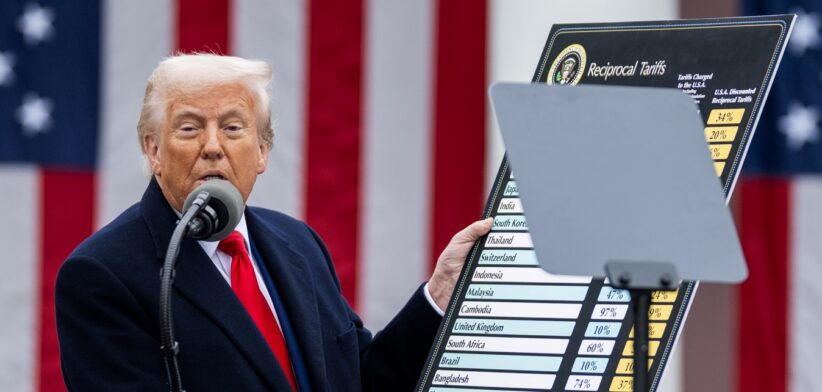By Drew Klease
Through the daily news cycle and the headlines streaming out of Washington, it can be easy to lose sight of the bigger picture. With the first half of the year now behind us, it is a good opportunity to take stock of the current state of the global economy.
While the global economy has held up better than expected following President Trump’s Liberation Day announcements, the economic performance has been weaker than expected at the start of the year. Back in January, QIC was expecting the global economy to expand at a 3.2 percent pace in 2025 (on a PPP weighted basis).
Now, we are looking for global growth to average around a 2.9 percent pace. Although we expect growth to be below-trend, we do expect a recession will be avoided.
Much of the downgrade to our global forecasts reflects the impact of Trump’s tariffs, particularly on the US economy. Official GDP numbers for the US reveal the economy contracted at a 0.5 percent annualised pace in Q1.
Although official numbers have not yet been released for Q2, a widely followed tracking estimate produced by the Atlanta Fed is pointing towards growth around a 2.4 percent annualised pace.
We caution against reading too much into the quarterly momentum of these GDP statistics, with the tariff shocks contributing to huge swings in imports that have likely complicated GDP measurement somewhat. Nonetheless, looking through the quarterly volatility, the US economy has likely expanded at close to a 1% annualised pace on average in H1 2025.
This is significantly below trend, and a sharp slowdown from the 2.8 percent annual average growth seen in 2024.
Looking ahead, we expect growth in the US economy to remain close to the pace seen in H1 2025, if not a touch softer, in H2 2025. While significant uncertainty remains over where Trump’s tariffs will ultimately land on August 1, it is telling that the trade deals that we have seen over the past couple of weeks have tariffs in the 15-20 percent range, including for Japan (15 percent down from 25 percent threatened), Indonesia (19 percent down from 32 percent) and the Philippines (19 percent down from 20 percent).
Reports are also emerging that the EU is close to negotiating a 15 percent tariff rate, down from Trump’s threat of 30 percent.
These tariffs are above the 10 percent rate that we saw for most countries in Q2, following the 90-day pause that President Trump declared shortly after Liberation Day. Our current baseline tariff expectation is for more trade deals over the coming weeks, and we expect the US effective tariff rate to be around 17 percent, below the 20 percent rate that we estimate based on Trump’s threats for August 1, but well above the 14 percent we saw in late May/early June.
In our view, the lagged impact of these tariff hikes is likely to see growth outside the US slow in H2 2025. With many countries attempting to front-run shipments to the US ahead of the tariff increase, inventories have built up in the US and we expect to see some payback and a slowing in global manufacturing activity in the second half of the year as these impacts wash out.
Not surprisingly, two economies facing the biggest hit from the US tariffs are Mexico and Canada. Growth in these economies has slowed and we wouldn’t be surprised to see them contract in Q2 based on incoming partial data.
The tariff headwinds are likely to continue to constrain growth in H2 2025, and we have downgraded our 2025 full-year forecasts since January from 1.8 percent to 1.3 percent in Canada and from 1.3 percent to 0.3 percent in Mexico.
Turning to Europe, growth in the euro area and the UK economy has surprised to the upside in early 2025, with strong Q1 quarterly annualised growth performances of 2.5 percent and 3 percent respectively.
However, momentum has slowed sharply in Q2 and sluggish growth is expected over H2 2025. Nonetheless, given the better-than-expected start to the year, we continue to expect euro area real GDP growth to average 1.1 percent in 2025, in line with our forecasts back in January.
For the UK, our growth forecasts have been trimmed to 1.2 percent in 2025, compared to our 1.3 percent growth expectations at the start of the year.
One country where we have seen forecast upgrades has been in China. Notwithstanding the trade war, China’s economic growth has held up surprisingly well over H1 2025.
Real GDP growth released last week revealed the Chinese economy expanded at a 5.3 percent annual pace in H1 2025, helped in part by stimulus efforts and consumer goods trade-in programs to support domestic spending.
However, we expect growth will slow in H2 2025 as the impact of these stimulus efforts fade and the lingering property market downturn continues to constrain activity. Nonetheless, our current forecasts expect growth in the Chinese economy to average around a 4.7 percent pace in 2025, above our January forecasts of 4.5 percent.
Inflation outturns over H1 2025 have been mixed, although typically reveal an ongoing gradual disinflation trend across the global economy. Looking ahead, we expect inflation to continue to converge towards most major central bank targets over the next year.
The notable exception is the US, given the likely impacts from tariffs. Although there has only been limited tariff induced pass-through to consumer prices in Q2, we expect to see a larger impact materialise over H2 2025, with the US core PCE inflation rate forecast to climb from 2.7 percent in May to 3.25 to 3.5 percent by the end of the year.
Nonetheless, given the Fed’s dual mandate, we expect the US Federal Reserve will look through the tariff induced inflation pick-up and instead be swayed by a softening labour market, and we expect 50bps of cuts by the US Federal Reserve in H2 2025.
However, it won’t take much for the Fed to decide to delay its cuts. Amidst all the volatility and significant shocks, H1 2025 was a relatively easy period for the US Fed to formulate monetary policy. H2 2025 looks anything but easy, not helped by the attacks on the Fed from the White House.
– Drew Klease is Principal Economist at the Queensland Investment Corporation (QIC).








